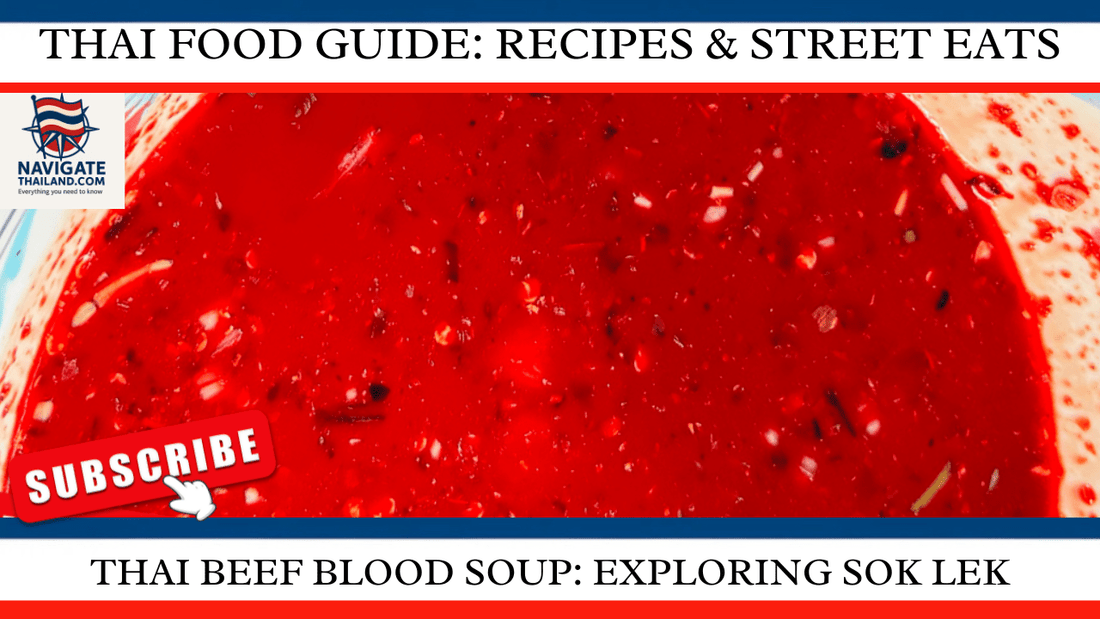
Thai Beef Blood Soup: Exploring Sok Lek and Other Raw Meat Delicacies in Thailand
Share
In the rural heartlands of Thailand, especially in the Isaan region, you’ll find a dish that surprises even the most adventurous travellers: raw beef blood soup. Known locally as Sok Lek (ซกเล็ก), this traditional delicacy isn’t for the faint-hearted. Made from freshly minced raw beef, herbs, lime juice, spices, and — crucially — raw cow’s blood, Sok Lek is as culturally rich as it is controversial.
This blog explores Sok Lek’s origins, preparation methods, health considerations, and its place in modern Thai culinary culture. We’ll also look at similar dishes from other parts of the country, so you know exactly what to expect if you’re curious enough to taste it during your travels.
What Is Sok Lek?
Sok Lek is a raw beef salad-style dish that hails from Thailand’s northeast (Isaan). It typically includes:
- Thinly sliced or minced raw beef
- Fresh cow’s blood
- Lime juice and fish sauce
- Chopped mint leaves, coriander, shallots, and green onions
- Ground toasted rice for texture
- Crushed red chili for spice
The ingredients are mixed by hand just before serving, ensuring freshness and maintaining the cold temperature that locals believe helps prevent spoilage.
It’s traditionally eaten with sticky rice and often paired with lao khao (rice whisky) — a popular accompaniment in rural settings.
Variations Across Thailand
While Sok Lek is the most well-known version, other regions of Thailand have similar dishes with their own unique flair:
1.
Larb Leuat Neua (ลาบเลือดเนื้อ)
– Northern Thailand
This variant of larb includes raw beef and blood, but with a heavier emphasis on spices and roasted chili. In Chiang Mai and Nan, it’s sometimes served with bile for added bitterness.
2.
Koi Neua (ก้อยเนื้อ)
– Lao Border Influence
Popular near the Laos border, Koi Neua often features thinly sliced beef marinated in a bloody citrus-spice mix, without as much liquid blood as Sok Lek.
3.
Luu Moo (หลู้หมู)
– Northern Variant with Raw Pork
Less common today due to health risks, this dish uses raw minced pork and pig’s blood. Found more in older or tribal communities, it’s considered highly risky by modern health standards.
Health Warnings & Modern Cautions
Let’s be real — Sok Lek and similar dishes are not without risks. In fact, Thai health authorities have launched numerous campaigns discouraging their consumption due to potential exposure to:
- Bloodborne parasites and bacteria
- E. coli and Salmonella
- Streptococcus suis, a potentially fatal pig-borne infection in raw pork dishes
For travellers, it’s strongly advised not to eat these dishes unless prepared by reputable, modern establishments using hygienic methods and chilled meat from trusted sources.
Where (and How) Travellers Can Try It in 2025
Although Sok Lek is more commonly eaten in homes and rural markets, there are safer ways for the curious foodie to try it:
1.
Ubon Ratchathani & Yasothon
Some restaurants here serve lightly seared versions or “fusion” Sok Lek, catering to urban Thais and tourists who want the flavour without the raw danger.
2.
Bangkok’s Isaan Food Hubs (e.g. Huai Khwang or Lat Phrao)
A few restaurants offer Sok Lek-style dishes with flash-seared beef to retain the texture and taste, but eliminate risk.
3.
Chiang Mai’s Lanna Dining Scene
Northern-style larb with blood can be found here — again, often modified for safety. Ask for it “suk suk” (สุกๆ) if you want it cooked.
Cultural Significance
For many rural Thais, Sok Lek isn’t just food — it’s part of identity, celebration, and community. It’s often shared during cattle-slaughtering events, family reunions, or rice harvest festivals. Elders believe it boosts strength, virility, and masculinity, much like rare steak traditions in the West.
Conclusion
Sok Lek and its raw beef blood relatives might seem extreme, but they reveal the unfiltered, fiercely proud culinary traditions of Thailand’s countryside. If you’re travelling through Isaan in 2025 and tempted to try this dish, remember: tradition meets taste — but safety always comes first.
Would you try Sok Lek? Or have you already? Share your experience in the comments below. And don’t forget to tag a foodie friend who might be up for the challenge!
Read more of our Thailand blog series:
Thai Food Guide:Traditional Recipes and Street Eats
Everything Travellers Need to know
Thailand travel ebooks and language guides
Thailand Travel Apparel & Souvenir Gifts
Subscribe to our YouTube channel Navigate Thailand to see our most popular Thailand travel blogs turned into videos:
Navigate Thailand YouTube channel










































































































































